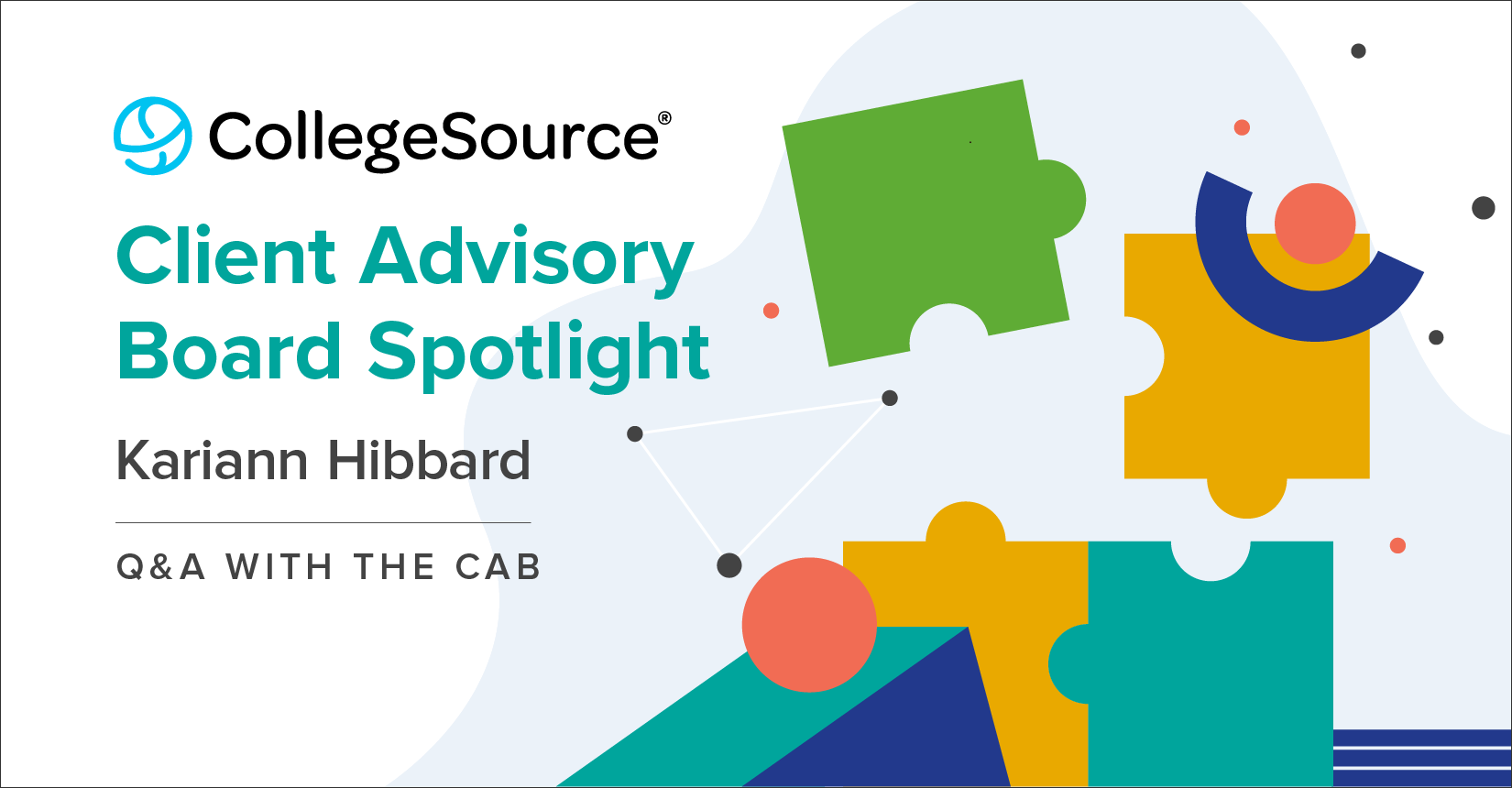
CAB Spotlights help you get to know the current Client Advisory Board members. The CAB serves as a liaison between CollegeSource and the community of professionals using CollegeSource software to maximize the higher education experience. Each spotlight is presented in a “Q&A” interview style and provides insights into CAB members’ institutions, what they are passionate about, and their perspective on issues within the higher education community. Additionally, CAB members may share anecdotes, advice, and what they have learned from being on the CAB.
We hope that these articles give you a new way to connect with the CAB and appreciate why each member was selected to represent our user community. In this portion of the series, we are excited to highlight one of our members.
Meet Kariann Hibbard. And, if you have not yet, check out the CAB panel session featuring Kariann from the 2021 CollegeSource Virtual Conference:
▶️ Ask the CAB: Degree Achievement
Panelists Include: Chris Akers, Virginia Tech, Kariann Hibbard, University of Utah, Drew Lurker, Ivy Tech Community College, Wil Perkins, Harding University, & Christina Shell, Eastern Michigan University
In the Spotlight: Kariann Hibbard
 Kariann Hibbard is currently the Business Systems Analyst, Sr., at the University of Utah. She has been with the institution for six years and previously worked as its academic advising coordinator and primary curriculum encoder for the uAchieve Degree Audit, known as DARS (Degree Audit Reporting System) on campus. Prior to her time at the University of Utah, Kariann held a position in academic advising at Arizona State University.
Kariann Hibbard is currently the Business Systems Analyst, Sr., at the University of Utah. She has been with the institution for six years and previously worked as its academic advising coordinator and primary curriculum encoder for the uAchieve Degree Audit, known as DARS (Degree Audit Reporting System) on campus. Prior to her time at the University of Utah, Kariann held a position in academic advising at Arizona State University.
In her role now, Kariann is embedded in IT on a team that supports the software that campus partners use. She assists in navigating the challenges that occur when the owner of the software isn’t the same group that implements and services that software, including identifying requirements and setting priority deadlines. In regards to DARS, she acts as the project manager with any DARS-related projects and ensures their functional users in the Registrar’s Office (those who do the bulk of the work with DARS) are aware of any issues or outages that occur.
University of Utah uses TES, Transferology, uAchieve Degree Audit, and uAchieve Planner from CollegeSource.
Do you participate in any associations, industry conferences, or online groups? How does interacting with your peers from other institutions help you perform your job more effectively?
Outside of CollegeSource and the CAB, I participate in HEUG, the Higher Education User Group, and a users group for our mobile application. Interacting with peers from other institutions helps me find ideas and solutions that are “outside of the box” for my university. When you spend every day putting out small fires, you don’t always have the time to figure out why the fires are happening and how to stop them before they start. Networking with peers outside of my university helps me to identify solutions to problems, sometimes before we even know the problem exists.
What advice can you offer first-time attendees or users trying to decide about attending the CollegeSource Annual Conference? What tips can you give to help them be successful and get the most out of the experience? What should they know before they go?
The CollegeSource Annual Conference was my first conference, ever, so I thought that’s what every conference for every company would be like. The next year I went to the Alliance conference and I was like a deer in the headlights. There were too many people, too many sessions, too many vendors, and too many ways to get lost, even in my hometown. So my first piece of advice is to enjoy it. Those who attend the CollegeSource conference are folded into the CollegeSource family.
Second, I recommend you spend time in the months/weeks leading up to the conference coming up with questions you want to be answered at the conference. What challenges are you facing at your university? What projects will you start in the next year? What is something you want to do with the products but haven’t yet?
Finally, I recommend you psych yourself up and get out of your shell. As an introvert, conferences can be challenging for me. But the size of the CollegeSource conference makes it easier for me to ask questions, talk to strangers, and network—and it 100% pays off! You will get out of the conference what you put into it, so put your whole self in and you will leave with new ideas, new solutions, new networks, and new friends.
What is something fun that the community might want to know about you?
I play the bagpipes! I’m eager to get back to in-person conferences so you can all hear me practicing while you’re watching the sunset on the beach!
What have you learned about being on the CAB? Why might you encourage others to apply?
The CAB has some incredibly smart people on it! I have learned so much about transfer (remember, I’m a curriculum gal, so I didn’t know a lot about transfer), mining and using degree audit data, and encoding solutions. I have learned more about the CollegeSource company and felt like my voice was heard. I have had so much fun helping to plan the CollegeSource Annual Conference. I think my biggest takeaway from being on the board is how much CollegeSource cares about its client institutions and the people who use their products every day. Being a member of the CAB has made each conference so much more immersive and fun. I absolutely encourage you to apply for the CAB!
Tell us about projects or objectives the CAB is working on now that you can share insight or progress made.
Lately, we have been discussing and problem-solving issues related to Army IgnitED, something that we realized was a much larger issue when we started talking about it together. Although it’s in the past now, we were also working on transfer week. Outside of that, we are all quite excited about the changes coming to the uAchieve Planner with the 5.0 release next year!
Reflecting back over your years in higher education, what do you see as having changed that may not be understood or apparent to someone from the outside or who has just joined the community?
The shift to fully utilizing and being fully dependent on technology. This seems so normal now, but there has been an incredible amount of work and effort devoted to getting here.
What do you see as a recent trend or on the horizon for Higher Ed? What problems do you think it will have to solve?
The biggest (and most obvious) trend, and not just in Higher Ed, is the switch to having technology “in the cloud.” This eases the burden for testing updates and upgrades on IT and mitigates the need for universities to have their own disaster recovery systems, but it comes with a steeper price tag and often results in a reduced ability to customize the product. I think cloud-based companies will need to find easy ways for their functional users (not IT) to customize their products. They will also need to further reduce the burden on IT by making requests for new or additional data from an integrated product easy to request/change. This will likely require a shift at universities as well. If universities are paying an increased price for cloud products, they have to come up with that money somewhere. This means that future products will have to require very little work from institutional IT teams.
What is the best thing about your job? The most challenging thing? What strategies do you use to provide better service?
The best thing about my job is the people I get to work with. The most challenging thing about my job is the people I have to work with. As a business analyst in product management, my job is all about people and helping to make sure their jobs are easier. Sometimes that means learning to do something new, like reading and writing SQL. My university has a subscription with Udemy and there are thousands of courses available. I keep my job fresh by learning new skills that I can use to help the teams I work with.
Why CollegeSource? What do our products do for you that is critical to your and your students’ success?
I don’t know why my university first decided to use CollegeSource (that decision is about 25 years before my time), but we keep using it because the encoding is fairly straightforward, the degree audit is easy for students to read, and transfer articulation works well for our needs. We are so very reliant on our CollegeSource products working that we have added it to our disaster recovery program (we are not yet in the cloud). The CollegeSource products allow us to easily monitor our students’ progress and know when they have completed all requirements for graduation. Because the audit is easy for advisors and students to read, we can use the same system for academic advising that we use to certify graduation. This allows our advisors to properly advise without the frustrations that other universities have. We implemented the use of markers within our encoding a few years ago and although this has helped us maintain programs and requirements easier, we realized after the fact that by using markers the way we did, we limited our ability to use some delivered features of CollegeSource products. When we’re ready for a large encoding project, we will change the way we’re currently using markers so that we can better utilize these additional features.

0 Comments